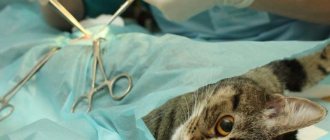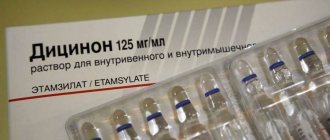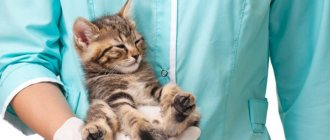Why are cats sterilized?
Sterilization greatly reduces the pet’s sexual activity or even reduces it to zero. After the operation is done, hormonal surges will stop, so the animal will become calmer and will no longer be eager to go outside to find a cat there.
Sterilization is beneficial for the pet's body: if a cat's heat is not accompanied by mating, diseases of the reproductive organs may develop - for example, inflammation of the uterus, and problems with the ovaries and mammary glands are also possible. There are many studies showing that sterilized cats live longer on average.
Finally, sterilization is guaranteed to prevent the birth of offspring, with which sometimes you have to tinker a lot - after all, finding owners for all the kittens, especially if there are many of them, can be difficult. If your pet roams freely on the street, then sterilization will also help reduce the likelihood of contracting something from other animals, especially stray ones.
Veterinarian advice
The best time for the procedure is early morning. It is recommended to perform the operation at this time so that when recovering from anesthesia the cat is not left to its own devices. During the day you will have to monitor the condition of the pet and stay close to it.
When heading to the veterinary clinic, make sure you have the correct carrier. Best of all, with a removable top. This is necessary in order to move the animal as little as possible after the operation. You will also need a blanket or bandage after sterilization.
It is recommended to place an absorbent diaper on the bottom of the carrier or basket. Animals perceive anesthesia differently and may involuntarily wet themselves under its influence. Also, the diaper will absorb discharge from the postoperative wound, if any.
Veterinarians say that the best age for sterilization is 8-10 months. At this time, the cat’s body is fully formed and mature. The main thing is that the operation is performed before the first signs of puberty appear.
Surgery in adult cats helps prevent cancer. Therefore, if sterilization was not carried out on time, this is not a reason to completely abandon it. The main condition is that the pet must be healthy.
Types of cat sterilization
There are different ways to stop reproductive function and remove the organs that are responsible for it. The following are usually used:
- Ovariectomy - in this case, the uterus is not affected in any way, only the ovaries are removed. The method is suitable for young and unborn cats
- Hysterectomy - on the contrary, the uterus is removed, but the ovaries are preserved. Estrus and corresponding behavior will remain after this operation, so it is performed relatively rarely, only in special cases, if there are medical indications.
- Ovariohysterectomy – This operation removes both the uterus and ovaries. It is carried out for adult and postpartum cats, as well as for pathological changes in the uterus.
The methods of performing the surgical procedure can also be different:
- incision on the abdomen along the white line;
- side cut;
- ultra-small incision - a surgical hook is used for it;
- laparoscopy – endoscopic equipment is used to perform removal through punctures.
Which of these options is preferable is determined by the veterinarian depending on the characteristics of the pet’s body, as well as on what operation is chosen.
Another method stands a little apart - tubal occlusion. During this operation, the fallopian tubes are tied, but the reproductive organs are not removed. The cat still goes into heat and behaves the same as before, but she is no longer able to become pregnant. There is a risk associated with this operation - tumors and cysts may form in the ovaries and uterus.
Sterilization can also be chemical, but it is temporary. If this option is chosen, no surgery is performed; instead, the animal is given a drug that reduces hormone production so that sexual activity is suppressed. Chemical sterilization is used in cases where offspring are required from a cat, but not in the near future.
Frequently asked questions about sterilization
The most popular questions from visitors are answered by veterinary medicine doctor Sergei Anatolyevich Tanyukevich.
How long does it take to sterilize a cat?
Typically, the time spent on the actual operation is 15–30 minutes, but sterilization is preceded by an examination of the cat, a conversation with the owner about the animal’s well-being, and the administration of anesthesia. And after sterilization, a blanket is put on, and the cat owner is consulted about postoperative care. As a result, sterilization usually takes 40-60 minutes.
Does a cat need to be vaccinated before sterilization?
Veterinarians recommend vaccinating your cat at least a month before sterilization. This will significantly reduce the risk of getting a viral infection in a veterinary clinic, which often houses animals with various diseases, including viral ones. Anesthesia given to a cat during sterilization can reduce the body's immunity. Therefore, it is advisable to vaccinate your cat and plan surgery in a month.
Can a cat be spayed while in heat?
During sexual heat, recovery from anesthesia and healing of sutures may be more difficult than usual. So we recommend spaying two weeks before or two weeks after heat.
Should a cat be allowed to give birth before being spayed?
No need.
Many cat owners are mistaken in believing that the cat must first give birth. Let's look at why you shouldn't do this. Manifestations of sexual heat in a cat are caused by the production of estrogens. In a cat that has not given birth, these hormones are produced only in the ovaries, and after sterilization, all unwanted effects for the owner disappear. After the cat gives birth, other endocrine glands begin to produce these hormones, and sexual behavior can continue for a long time.
Is it possible to sterilize a pregnant cat?
In the early stages, sterilization can be done.
On later ones it is also possible. The procedure is called “extirpation of the pregnant uterus” and is usually performed for medical reasons to save the life of the female. We usually do not recommend sterilizing a healthy pregnant cat, since during pregnancy the animal’s body undergoes significant changes at both the hormonal and physiological levels. There is a possibility of high blood loss and longer recovery of the animal after sterilization. In addition, the suture after sterilization of a pregnant cat is much larger in size.
When can a cat that has given birth and is nursing kittens be spayed?
First you need to wait until the kittens are weaned. Then, after stopping feeding, it is advisable to maintain a time interval of 2-3 weeks so that the mammary glands completely return to normal. After this, sterilization can be carried out.
How to feed a cat after sterilization?
Changes in the hormonal background of the body after sterilization can stimulate physical inactivity, but obesity will not occur if the diet is followed. It is important to follow the food manufacturer's recommendations printed on each package and feed in portions according to your cat's weight. Also, food manufacturers have special series for sterilized cats with reduced calorie content.
Will my cat continue to catch mice after sterilization?
Yes, it will continue, in terms of the cat’s hunting instincts, nothing will change.
Preparing for sterilization
The operation itself can be performed either in a veterinary clinic or at home, but it is necessary to prepare for it in both cases. First, the pet must be vaccinated against infectious diseases - 4 weeks or more should remain before the procedure. Another thing that needs to be done before the operation, a week or two before, is deworming.
Be sure to consult with your doctor in advance, undergo all the tests prescribed by him and take tests. All this is necessary so that no complications arise - for example, if the animal has problems with the lungs, heart or some other organs, the operation may not go according to plan. If you make sure in advance that there are no problems, they will not arise during sterilization. Cats over 10 years of age need to be checked especially carefully.
If everything is in order, surgery will be scheduled. To avoid vomiting during and after anesthesia, you should not feed your cat for 12 hours beforehand, and stop giving water 2 hours beforehand. It is also worth purchasing a blanket that is the size of the cat so that it cannot lick the wound, and this blanket will also prevent damage and dirt from getting into the wound.
Preoperative period
He should never be underestimated. Any surgical intervention, whether planned or emergency surgery (procedure), carries certain risks to the life and health of the animal. This is due to the fact that operations and some procedures (manipulations) are performed under general anesthesia (anesthesia). The success of surgery and subsequent recovery directly depends on the preoperative preparation of the pet. During this period, the doctor draws up a general picture of the animal’s condition, determines the severity of the underlying disease and the presence of concomitant disorders (for example, cardiac ones). To minimize risks, the necessary examinations are carried out, and sometimes additional therapy is prescribed.
For healthy animals up to 7 years old
Elective surgeries (for example, spay and neuter) or procedures under anesthesia (ultrasound teeth cleaning, x-rays under sedation) are most often performed without additional examinations of pets. But only if they are under seven years of age and do not have a breed predisposition to heart disease. Such operations are prescribed without first seeing a therapist, and you can sign up for them simply by calling.
For animals over 7 years old or with a history of diseases
Pets in this age category must first see a therapist. This also applies to animals with any diseases (for example, chronic kidney disease or acute liver failure). And in the case of tumor processes, you should make an appointment with an oncologist and surgeon in advance. For such animals, the day of surgery is assigned only after all the necessary examinations.
They must:
- General and biochemical blood test. A general blood test shows the level of leukocytes, red blood (to exclude anemia), and the number of platelets.
- Biochemistry
. It is necessary to assess the functionality of the kidneys and liver in older animals (over 7 years old), since many diseases of the liver, kidneys and heart can occur chronically, without clinical signs and symptoms, and during surgery they can lead to complications and even death of the animal.
Additional tests ordered for some animals
Radiography
It is necessarily carried out to exclude lung pathology, if tumor metastasis is suspected, etc.
Ultrasound
The study is carried out to visually assess the abdominal organs. It is prescribed for suspected presence of free fluid in the chest or abdominal cavity, before cesarean section (including calculating the fetal heart rate), suspected tumor metastases or ruptures of abdominal organs, etc.
Cardiac research
An electrocardiogram (ECG) should be performed on older animals with a history of loss of consciousness, chronic cough, and periodically blue mucous membranes and tongue. It will help identify disturbances in the rhythm and conduction of the heart, as well as a lot of indirect signs of disturbances in the functioning of the heart and its structure.
ECHO of the heart is used to determine the size of the chambers and muscles of the heart, to assess the function and structure of the valves, to detect regurgitation (backflow of blood), etc. It is necessarily carried out in purebred cats to exclude hereditary pathology - hypertrophic cardiomyopathy (HCM). All necessary tests can be completed in one or several days.
After examination and research, you can:
- draw conclusions about the need for surgical intervention (or performing one or another manipulation under anesthesia);
- set the time and date of the operation;
- carry out preoperative therapy in cases of abnormal test results.
It is very important that the animal is as stable as possible before anesthesia.
If the tests are good, surgery is scheduled for the near future.
If the operation is emergency, tests are prescribed individually in each case, taking into account the condition of the animal.
At home the day before surgery
Before surgery, a fasting diet is required:
- for cats – 3–4 hours;
- for dogs – 4–6 hours, except for brachycephalic breeds (with a flat muzzle) – a fast of at least 8–10 hours is recommended for them;
- for puppies and kittens aged 1–6 months - fasting for no more than 4 hours;
- if surgery is planned for interventions on the gastrointestinal tract, gastroduodenoscopy - fasting for 10-12 hours.
The only exception is newborns (up to four weeks of age), they are delivered to the clinic together with nursing mothers.
The countdown is from the beginning of the operation, and not from the moment the animal arrives at the clinic.
For the specified period, absolutely any food should be excluded, and water should not be given 1 hour before the operation. This is due to the fact that when the animal is given sedation or anesthesia, vomiting of feed may occur. If this happens, there is a risk of developing aspiration pneumonia. Therefore, a fasting diet is extremely important.
In the clinic on the day of surgery
On the appointed day, immediately before the operation, the necessary information is collected and the animal is thoroughly examined by an anesthesiologist. Next, the patient is taken to the hospital for the necessary surgical intervention. Pedigree cats undergo cardiac ECHO on the same day (or in advance). After consultations with the anesthesiologist, the pet's owners sign a written consent to give the animal anesthesia and deposit the necessary funds into the balance. The owners' participation is no longer required at this stage; they can leave the clinic.
Care in the first hours
After returning home, the cat needs to be placed on a bed, a towel, a blanket - in a word, something comfortable; If the house is cool, you should cover it. When performing the operation at home, you need to proceed in the same way.
It is important not to place your cat on the sofa or other elevated surfaces. When she wakes up, she will not immediately return to normal after the anesthesia, so there is a risk of falling. For the same reason, there should be no sharp corners or other objects near the place where you place the cat that could injure the cat. If the season is cold and the room is cool, heating after anesthesia is very important, but you should not place the cat near a radiator or heater.
Small children can harm a newly operated animal, so you should not let them get close at first. It's the same with other animals - just in case, it's better to keep them away.
When a cat is just starting to come to its senses, you should not leave it alone. During anesthesia, when her eyes do not close due to the effects of the drug, saline or boiled water must be periodically instilled into them. This needs to be done until the cat starts blinking them. Dropping liquid into the eyes will prevent the cornea from drying out, so the animal will not experience additional discomfort due to this.
Pros and cons of sterilization
Sterilization, like any surgical process, has advantages and disadvantages.
The arguments “For” include the following arguments:
- a cat is capable of bringing kittens not only annually, but even quarterly, up to 6 kittens at a time. Not all owners want to solve the problem of finding homes for all their children;
- the behavior of an animal during estrus is often inadequate: nighttime guttural cries, lack of appetite, a pervasive smell of urine in the house due to the cat’s desire to mark everything around with its smell;
- if there are babies in the house, a sterilized animal will not bring infection into the house;
- bearing and giving birth to offspring can cost the life of the owner’s beloved cat;
- if a cat is not allowed near the cat during heat, then a large amount of extra hormones appears, which has a detrimental effect on the pet’s psyche;
- increasing the lifespan of a cat.
It is also worth listening to the arguments “against” and drawing conclusions: this is an invasion of the natural course of events planned by nature. It turns out that a person first of all worries about his own peace of mind, and only then about the health of his pet.
The operation may not go as smoothly as we would like; it is difficult for the animal to recover from anesthesia and regain strength.
It is also important to understand that sterilization of a cat is an irreversible process, and the owner will never see kittens from his pet.
Care after the cat recovers
After returning to consciousness, the pet will move uncertainly for some time - it will stagger, and perhaps even fall. You shouldn’t be scared, this is normal, the main thing is to provide such conditions so that the animal does not get hurt.
It is also possible that the cat will become aggressive - there are often cases when, upon waking up after surgery, it begins to hiss and even bite. She may also try to hide somewhere in a distant corner or climb up - the latter is especially dangerous due to the fact that she has poor control of her body. Therefore, you still don’t need to leave her alone, you should make sure that these few hours pass without consequences. If the cat is too active and does not want to calm down, it is better to lock it in a carrier and wait until it fully comes to its senses.
Medicines after sterilization
In some cases, doctors advise administering antibiotics, but if there is no such recommendation, you should not do this, and even more so, you should not use medications intended for people - they can be harmful.
Sometimes it is necessary to carry out additional processing of the seams. If such a need arises, the specialists who operated on the cat will instruct how to do this. If such treatment is not needed, then you just need to inspect the seams - they should be dry and clean. If you notice festering, you should consult a doctor.
If you are not sure that you can provide good care for your cat, or are busy after the operation, it is better to carry it out in a hospital and leave the animal there under the supervision of doctors.











